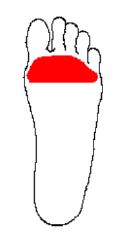The aim of this advice is to give you some understanding of the problems you have with your foot and to provide some advice on how to manage this. It is not a substitute for professional healthcare advice and should be used in conjunction with verbal information given by your GP or AHP.
 What is Metatarsalgia?
What is Metatarsalgia?
Metatarsalgia is the name given to pain felt under the Metatarsal heads (the ball of your foot area on the sole of the foot just before your toes).
How Common Is It?
It usually occurs in and after middle age as is quite common. It can occur in younger people particularly athletes.
What are the symptoms?
Metatarsalgia usually comes on gradually over some weeks rather than suddenly.
The affected area may feel tender when you press on it. Pain on weight bearing through the foot. This is often described
as similar to walking on pebbles or having a stone in the shoe. The foot can be swollen and stiff.
Why does it occur?
- There are many causes of metatarsalgia:
- Being overweight- This can put extra stress on the feet in general
- Wearing high heeled shoes or wearing footwear that is poorly fitted or too tight
- Altered foot mechanics such as a high arched foot, claw or hammer toes and bunions.
- Stiff ankles
- Arthritis and Gout can cause inflammation of the joints in the ball of the foot or of the big toe
- Overuse injury in athletes and walkers
- A stretched or irritated nerve in the ball of the foot, this is also known as a Morton’s Neuroma.
- Diabetes can cause damage to the nerves in the feet and can also be a cause of metatarsalgia.
What are my treatment options?
- Resting with your feet elevated (up).
- Wearing well fitted shoes with a low heel and a wide toe area.
- Reducing your weight.
- Putting metatarsal pads in your shoes to help relieve pressure on the ball of your foot.
- Physiotherapy. A thorough assessment of your foot and ankle will be carried out. Treatment may include advice and exercises.
- Podiatry biomechanical assessment
- Foot insoles
- Injection of steroid in to the foot is sometimes
- performed in more severe cases.
Prevention
Wear good supportive footwear and avoid prolonged wearing of high heels.
Medication
Many people use medication to help them remain active and to cope with their pain and symptoms. It is recommended that you take your medication regularly. It is best to get advice from a GP or pharmacist.
Other Intervention
There are other health interventions which may be more appropriate for your condition. These can be discussed with your health care practitioner.
Work
It is usually recommended that you try to stay at work or get back to work as soon as possible. You do not need to be fully pain and symptom free to return to work. Research shows the longer you are off work the less likely it is that you return.
Investigations/do I need any special tests
The main way we diagnose your metatarsalgia is through what you tell us and by examining your foot. Other investigations may be considered, these can be discussed with your health care professional.
Try to stay positive. There is a lot you can do to help yourself. Most symptoms do settle with time.

